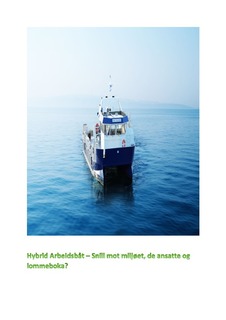| dc.contributor.advisor | Petersen, Terje | |
| dc.contributor.advisor | Trondvold, Arnt Erik | |
| dc.contributor.author | Brækken, Pål | |
| dc.date.accessioned | 2019-09-06T14:06:02Z | |
| dc.date.available | 2019-09-06T14:06:02Z | |
| dc.date.issued | 2019 | |
| dc.identifier.uri | http://hdl.handle.net/11250/2613429 | |
| dc.description.abstract | Målet med denne rapporten har vært å vurdere om en hybrid arbeidsbåt er en lønnsom innvestering på sikt. I tillegg har gruppen sett på om hybride arbeidsbåter kan bidra positivt til arbeidsmiljøet og på utslipp av klimagasser.
For å kunne svare på problemstillingen er det blitt gjort en sammenligning mellom konvensjonell diesel- og hybrid arbeidsbåt. Det ble gjennomført møter med aktører i markedet, og det ble foretatt besøk på arbeidsbåter og oppdrettsanlegg. Dette for å finne de totale drifts- og vedlikeholdskostnadene som påløper gjennom levetiden til arbeidsbåten. Deretter ble det foretatt en LCC-anlyse av begge båttypene. Resultatet viser at til tross for en høyere investeringskostnad for hybridbåt, vil merkostnaden bli tilbakebetalt grunnet lavere drifts- og vedlikeholdskostnader for hybridbåten. Gruppen undersøkte flere driftsprofiler og resultatet viser at lønnsomheten ved overgang til hybridbåt er størst for anlegg som har båter med høye drifts- og vedlikeholdskostnader. Dette gjelder også for utslipp av klimagasser. Differansen for utslipp mellom hybrid og konvensjonell dieselbåt øker med antall driftstimer.
For å undersøke hybride arbeidsbåters innvirkning på arbeidsmiljøet ble det foretatt intervjuer og spørreundersøkelser av mannskapet på Elfrida, som er den eneste hybride arbeidsbåten i Norge. Resultat viser at til tross for en del tekniske problemer med hybride båter vil alle de spurte respondentene velge hybrid om de fikk velge på nytt. Alle respondentene nevner det gode arbeidsmiljøet som grunn for at de velger hybrid arbeidsbåt. | |
| dc.description.abstract | The purpose of this report is to consider whether hybrid working boats could be a long-term profitable investment. In addition the working group has considered whether hybrid working boats would make positive contributions both to the working environment and to lowered emissions of climate gases.
In order to answer these questions we have made comparisons between conventional diesel boats and hybrid working boats. We have carried out meetings with market-players, and we have visited various working boats as well as aquaculture plants, the purpose of which was to identify the total operational and maintenance costs through the life span of working boats. Thereafter we have performed an LCC-analysis of both types of boat. The results demonstrate that in spite of a higher cost of investment for hybrid boats, the additional cost will be repaid due to lower operational and maintenance costs for the hybrid boat. Our working group have explored various kinds of operational profiles, and the results clearly show that the obtainable profitability by changing to hybrid boats is highest for plants that have boats with high operational and maintenance costs. The same result applies to climate gas emissions. The difference between emissions from hybrid boats and from conventional diesel-powered boats obviously increases with increase in operational hours for the boats.
In order to explore effects of the use of hybrid working boats on the working environment we have been interviewing the crew of Elfrida, the only hybrid working boat in Norway, as well as using questionnaires. The result establishes that despite some technical issues all the respondents would choose a hybrid boat if they were to choose once again. All respondents emphasize the good working environment as the main reason why they would choose hybrid working boats. | |
| dc.language | nob | |
| dc.publisher | NTNU | |
| dc.title | Snill mot miljøet, de ansatte og lommeboka? | |
| dc.type | Bachelor thesis | |
